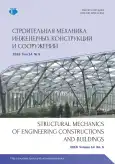Analytical and finite element modeling in the calculation and design of reinforcements of stretched elements by fiber-reinforced polymers based on high-strength fiber using adhesive joints
- Authors: Danilov A.I1, Kalugin I.A2
-
Affiliations:
- Moscow State University of Civil Engineering (National Research University)
- RKK Energy PJSC
- Issue: Vol 14, No 5 (2018)
- Pages: 414-426
- Section: Buckling analysis
- URL: https://journal-vniispk.ru/1815-5235/article/view/346339
- DOI: https://doi.org/10.22363/1815-5235-2018-14-5-414-426
- ID: 346339
Cite item
Full Text
Abstract
Subject . Analysis of applicability and effectiveness of various complexity level models in design of reinforcement of stretch elements by gluing on their surface high-strength fiber reinforced polymers (HSFRP). Research objectives. Determine the necessary level of complexity of the calculation model based on the comparison of calculation results obtained on models of various complexity within the elastic behavior of the reinforced element and analysis of features of its elastoplastic behavior in case of its overload. Materials and methods. Few relatively simple variants of HSFRP-reinforcement structures with application of four Finite Element Method (FEM) simulation models of varying complexity and an analytic approach. Plane and spatial Finite Element (FE) models with PC LIRA (SCAD) and FEMAP (NASTRAN) apply in considered series of numerical experiments. Comparative analysis of results of elastic FEM calculation based on various FE models with the results obtained using analytical expressions. A number of diagrams and tables represent the results of calculations. Nonlinear FEM analysis reveals some features of the reinforced elements response under extreme loads. Results. The effect of various factors on the bonded joint behavior observed, the equations and formulae for the analysis and design are applied, the analytical approach based numerical results well correspond with those obtained using FEM. A number of nonlinear FEM calculations discover some features of elastic-plastic response of joints. Conclusions. All the considered here FE models within the limits of elastic design are quite compatible mutually and with an approximate analytical approach as well. The least timeand effort-expensive for the stage of preliminary assessment of the various parameters effect on the glued joint behavior in the elastic design of the stretched elements reinforcement is an analytical approach allowing instantaneously obtain the resulting main components of stresses and forces in the components of joint to scroll through parameter values. FEM simulation for elastic calculation is expedient for verification of results. The simplified plain FEM simulation seems to be quite reliable here. In inelastic state of the reinforced element material yet, the features of its stress-strain distribution not observable in the elastic stage of its loading and requiring special attention and refined FEM simulation may dominate.
About the authors
Aleksandr I Danilov
Moscow State University of Civil Engineering (National Research University)
Author for correspondence.
Email: alenk904@mail.ru
Cand. Sci. (Eng.), Assistant Professor, the Department of Metal and Timber Structures
26 Yaroslavskoe Shosse, Moscow, 129337, Russian FederationIvan A Kalugin
RKK Energy PJSC
Email: kalugin_93@bk.ru
Bachelor, Construction Engineer
4A Lenina St., Korolev City, Moscow Region, 141070, Russian FederationReferences
- Ovchinnikov I.I., Ovchinnikov I.G., Chesnokov G.V., Tatiev D.A., Pokulaev D.V. (2014). Usileniye metallicheskich konstrukciy fibroarmirovannymi plastikami [Reinforcement of metal structures with fiber reinforced polymers]. Naukovedeniye, (3), 1-23. (In Russ.)
- Tusnin A.R., Schurov E.O. (2017). Eksperimentalnyje issledovanija kleevogo sojedinienija elementov iz stali i ugleplastikovych komposicionnych materialov [Experimental investigation of the glue joint between the steel element and carbon fiber reinforced polymers]. Promyshlennoje i grajdanskoje stroitelstvo, (7), 69-73. (In Russ.)
- Tusnin A.R., Schurov E.O. (2017). Eksperimentalnyje issledovanija stalnych elementov, usilennych ugleplastikovymi komposicionnymi materialami [Experimental investigation of the steel elements strengthened by the carbon fiber reinforced polymers]. Promyshlennoje i grajdanskoje stroitelstvo, (9), 25-29. (In Russ.)
- Danilov A.I. (2014). Kocepcija upravlenija processom razrushenija stroitelnogo objekta [The concept of the civil engineering object collapse process control]. Promyshlennoje i grajdanskoje stroitelstvo, (8), 74-77. (In Russ.)
- Tavakkolizadeh Saadatmanesh H. (2003). Fatigue strength of steel girders strengthened with carbon fiber reinforced polymer patch. Journal of Structural Engineering, ASCE, (129), 186-196
- El-Tawil S., Ekiz E., Goel S., Chao S.-H. (2011). Retraining local and global buckling behavior of steel plastic hinges using CFRP. Journal of Constructional Steel Research, (67), 261-269
- Tsouvalis N.G., Mirisiotis L.S., Dimou D.N. (2009). Experimental and numerical study of the fatigue behaviour of composite patch reinforced cracked steel plates. International Journal of Fatigue, (31), 1613-1627.
- Shaat A., Schnerch D., Fam A., Rizkalla S. (2003). Retrofit of steel structures using fiber reinforced polymers (FRP): state-of-the-art. Centre for Integration of Composites into Infrastructure.
- Nguyen T.-C., Bai Y., Zhao X.-L., Al-Mahaidi R. (2011). Mechanical characterization of steel/CFRP double strap joints at elevated temperatures. Composite Structures, (93), 1604-1612
- Bocciarelli M., Colombi P., Fava G., Poggi C. (2009). Fatigue performance of tensile steel members strengthened with CFRP plates. Composite Structures, (87), 334-343.
- Liu H., Al-Mahaidi R., Zhao X. (2009). Experimental study of fatigue crack growth behavior in adhesively reinforced steel structures, Compos. Struct., 90, 12-20.
- Harries K.A., Peck A.J., Abraham E.J. (2009). Enhancing stability of structural steel sections using FRP. Thin-Walled Structure, 47, 1092-1101.
- Patnaik A.K., Bauer C.L. (2004). Strengthening of steel beams with carbon FRP laminates. Proceeding of the 4th Advanced Composites for Bridges and Structures Conference, Calgary, Canada.
- Colombi P., Bassetti A., Nussbaumer A. (2003). Analysis of cracked steel members reinforced by prestressed composite patch. Fatigue Fract. Eng. Mater. Struct., 26(1), 59-67
- Täljsten B., Hansen C.S., Schmidt J.W. (2009). Strengthening of old metallic structures in fatigue with prestressed and non-prestressed CFRP laminates. Construction and Building Materials, 23(4), 1665-1677.
- Ghafoori E., Motavalli M., Botsis J., Herwig A., Galli M. (2012). Fatigue strengthening of damaged metallic beams using prestressed unbonded and bonded CFRP plates. International Journal of Fatigue, 44, 303-315.
- Ghafoori E., Schumacher A., Motavalli M. (2012). Fatigue behavior of notched steel beams reinforced with bonded CFRP plates: determination of prestressing level for crack arrest. Engineering Structures, 45, 270-283
- Ghafoori E., Motavalli M. (2013). Flexural and interfacial behavior of metallic beams strengthened by prestressed bonded plates, Composite Structures, 101, 22-34.
Supplementary files









